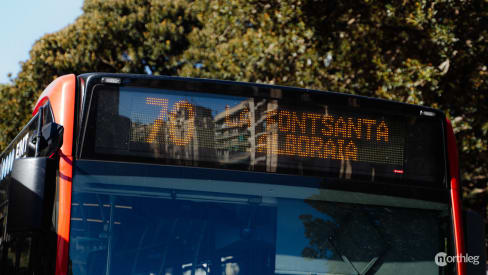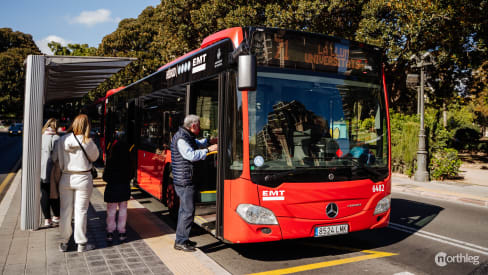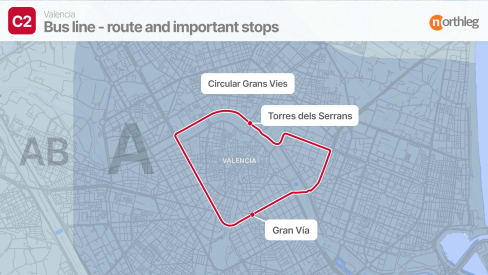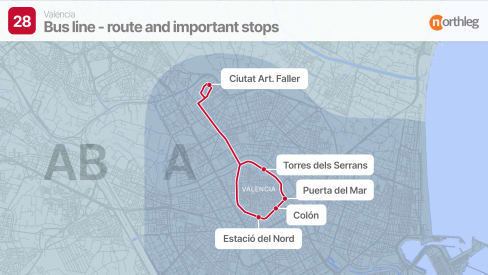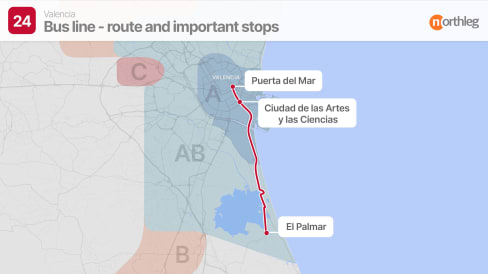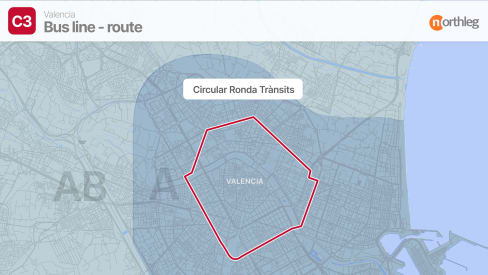Types of lines
Types of lines
In Valencia, there are two main kinds of public bus services, EMT and MetroBus.
EMT buses operate mainly in Zone A, connecting the city centre with the surrounding neighbourhoods. You can see many of their red buses moving around the city every day. EMT has 44 lines in total. Out of them, 23 are active as day/night lines, the other 21 are daytime-only lines.
On the other hand, MetroBus is an entity whose yellow buses, operated by different companies, are dedicated to connecting suburban areas and towns around Valencia.
The 150 MetroBus lines mostly dwell in zones B-C and might include Zone A in part of their journeys. During your stay, you will probably stay in the city centre, so you are unlikely to take non-EMT buses, except perhaps for your trip to and from the airport (MetroBus line 150).
Regardless of the managing company, these lines share the same prices, however, not all passes are valid for both companies. In the relevant section of this article, you can find the full details on tickets and passes.
Aside from these, if you want to travel between Valencia and other cities in Spain, other bus companies offer long-distance journeys. Alsa and Avanzabus , for example, have routes within the region and towards other cities outside the region too.
| Type of line |
|---|
| Characteristics |
| More info |
| Type of line | Urban buses | Night buses | Suburban buses | Long-distance buses |
|---|---|---|---|---|
| Characteristics | They are operated by EMT and move mainly in Zone A, the metropolitan area. They are the red buses you see around the city centre. | These too are EMT urban lines, but they are also active at night - specifically until 02:00 am (on weekdays), or 03:30 am (on weekends). | They are operated by MetroBus and move throughout zones A-B-C, generally connecting smaller towns around Valencia to one another or with the city itself. They are the yellow buses. | Private buses that connect Valencia with other cities in the region or the rest of Spain. The two main companies are Alsa and Avanzabus . |
| More info |
Urban lines (EMT)
With the term urban lines we refer to EMT public buses which primarily move through Zone A, with occasional stretches of the route in the A-B overlap zone. They are the red buses you will surely see in the city centre.
There are 44 of these lines making up a network that covers and connects the Valencia area nicely. On top of these, there are also other lines classified as special, as they are only active on particular occasions (like on All Saints Day), or on request.

In fact, EMT buses offer a door to door special service for people with functional diversity. This means that city bus services can be requested for a specific time and place outside the usual bus route and stops. The service is available 365 days a year, but to request it, you will have to call +34 963 158 525 at least two working days in advance. This telephone line is operational Monday to Friday between 8:00 am to 1:00 pm. Requests must be confirmed one working day in advance through a second phone call to the same number, same working hours.
In any case, the majority of buses with regular service in Valencia are fully accessible, with automatic and/or manual ramps to get on and off, as well as two wheelchair spaces with safety belts. Reduced fares might apply to accompanying persons.

Most EMT lines connect the historic centre of the city with some peripheral neighbourhoods around it. Here we will see some of the most useful ones for visitors.
Interesting urban lines
Some of the bus lines that you are most likely to take in Valencia are:
| Line |
|---|
| Details |
| Line | C1 | C2 | 28 | 24/25 | 19 | 31/32 | 92/93 | 95 |
|---|---|---|---|---|---|---|---|---|
| Details | It is a circular line that runs the length of the old city walls, hugging the old quarters of the city. Some of its stops are Puerta del Mar, Plaza del Ayuntamiento, Xátiva, Torres dels Serrans. | It circulates directly around the C1 route. It follows along Valencia’s tree-lined avenues and then for a stretch of the Turiapark, also including the university area in its route. | This line runs the entire length of the old city walls, circumscribing the old quarters of the city. It also goes into the neighbourhoods north of the centre for a stretch. | These two lines connect Valencia (from Puerta del Mar) to Albufera and the famous rice fields of the region. | It connects the central areas around Plaza del Ayuntamiento and Xátiva to the seaside, stopping by the Cabanyal neighbourhood, and near Les Arenes and Malvarosa beach. | Their routes go from the old quarters, around Colón and Xátiva, to the university areas. They then continue towards the maritime Cabanyal neighbourhood, near Les Arenes and Malvarosa beach. | Their routes follow the course of Valencia’s tree-lined avenues (Gran Vías), and then proceed towards the maritime neighbourhood, near Malvarrosa beach. | It follows the course of the Jardín del Turia in its entirety. Its route connects Avenida del Cid with Ciudad de las Artes y las Ciencias and then Neptú, by the harbour. |
Interesting stops
Here is a breakdown of the most interesting stops for daytime buses (mentioned in the previous section). These stops often represent important junction points between different bus lines or methods of transport. To see and read about each of them, swipe left.
Night lines
Out of the total 44 urban lines, 23 are also active as nocturnal lines. They are lines C3, 4, 7, 8, 9, 10, 14, 16, 19, 24, 25, 26, 27, 28, 60, 62, 67, 70 , 72, 73, 81, 93, and 99. During the week, these lines are operational until around 02:00 am, but on weekends, this time is extended until 03:30 am. The other 21 daytime-only buses are usually operational until around 10:30 pm.

In Valencia night buses subscribe to the Purple Stops Program, Paradas Violeta in Spanish. This means that after 10:30 pm, women on a bus can request a stop wherever they want, as long as it is within the usual route of the bus.
This way, women who travel alone, with another woman, or with a dependent person, can get off closer to their destination. To request this service, you will have to ask the driver upon getting on the bus and sit down as close as possible to them, as you will get off the bus from the front door, instead of the rear one like usual.
Interesting night lines
| Line |
|---|
| Details |
| Line | 19 | 24/25 | 28 | 93 | C3 |
|---|---|---|---|---|---|
| Details | It connects the central areas around Plaza del Ayuntamiento and Xátiva to the seaside, stopping by the Cabanyal neighbourhood, and near Les Arenes and Malvarosa beach. | These two lines connect Valencia (from Puerta del Mar) to Albufera and the famous rice fields of the region. | This line runs the entire length of the old city walls, circumscribing the old quarters of the city. It also goes into the neighbourhoods north of the centre for a stretch. | Its route follows the course of Valencia’s tree-lined avenues (Gran Vías), and then proceeds towards the maritime neighbourhood, near Malvarrosa beach. | This route runs all day and night, it circulates directly around the C2 route. It loosely hugs the whole city, passing behind Ruzafa, the two train stations, the neighbourhoods to the west and north of the city, including the university areas. |
Interesting stops
Here is a breakdown of the most interesting stops for nighttime buses (mentioned in the previous section). These stops often represent important junction points between different bus lines or methods of transport. To see and read about each of them, swipe left.
Suburban lines (MetroBus)
MetroBus is an entity that incorporates several bus companies. Together, they operate the 150 routes that make up this service, all of them day-time lines. These buses move mainly in zones B-C, connecting smaller towns around Valencia to one another or with the city itself (in which case they also move in Zone A). They are easily recognizable as they are the only yellow buses in the city.

They use the same zone distinction and the same fares as EMT buses. However, not all passes or tickets valid for EMT buses will be valid for MetroBus services. This is because, as mentioned, most MetroBus lines cross zones A-B-C, while EMT buses remain in Zone A.
It’s also important to remember that neither the Bonobus nor the Valencia Tourist Card is valid for MetroBus services.
Apart from bus 150 to Manises Airport, you won’t have much use for these lines, as they are generally dedicated to residents who live outside the city centre and need to move between towns.
In terms of luggage restrictions, you can take up to two suitcases with you on these buses, as long as there is enough room for everyone in the vehicle. Keep in mind that this is a city bus and not a coach bus, so your suitcases will travel with you.

Like most buses in the city, MetroBus lines will generally have two wheelchair spaces, and a manual or automatic ramp. For more details, you might want to check with the individual companies that run the service. In the case of line 150, you can check either on the Fernanbus website or call them (+34 96 150 00 82).
Line 150
Line 150 makes a total of 26 stops on its way to the centre. Some of the most central in the city include the Central Market, Àngel Guimerà, and Avenida del Cid, all busy areas with many connection points and stations, both in terms of buses and metro.

The Mercat Central is the modernist central market in the heart of Valencia’s old quarters. Àngel Guimerà and Avenida del Cid are two great connection points for other buses or the metro, both located west of the city centre. If you would like more information about this line, you can check out our article about how to move between Valencia and the Airport.
Long-distance buses
If you want to go to another city in Spain, either in the Valencia region (like Alicante) or in other parts of Spain, private, long-distance buses might be what you are looking for. The two main companies for these services are Alsa and Avanzabus .
The prices of course vary depending on the length, date and time of the journey. It is also important to note that booking a return ticket is generally cheaper than getting two separate tickets. Even if you are not sure when to get your return, most companies allow changes to one leg of the journey for little extra cost.
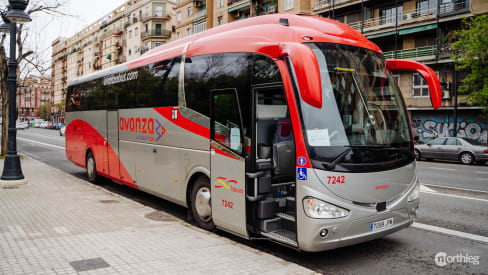
You will find that most buses of this kind depart from and arrive at Valencia bus station, located in front of the Turiapark, not far from the Turia metro stop.
Some of the most popular destinations in the region are Alicante and Benidorm (especially liked by families). Other cities that are easily reachable outside the community are Barcelona, Madrid, and Murcia.


